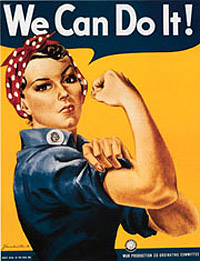| WOMEN IN TRANSPORTATION |
| Changing America's History |
|
Rosie the
Riveter
When the United States entered the Second World War, "Rosie the Riveter" became the symbol for women workers in the American defense industries. The diversion of men from the labor pool into the military, as well as the increased production needed to support the war effort, prompted the federal War Manpower Commission and the Office of War Information to undertake a nationwide campaign to recruit women into the labor force.
During the war years, women became streetcar conductors, taxicab drivers, business managers, commercial airline checkers, aerodynamic engineers, and railroad workers. Women operated machinery, streetcars, buses, cranes, and tractors. They unloaded freight, built dirigibles and gliders, worked in lumber mills and steel mills, and made munitions. In essence, women occupied almost every aspect of industry. |

Top: Rosie the Riveter WWII poster. | |
|